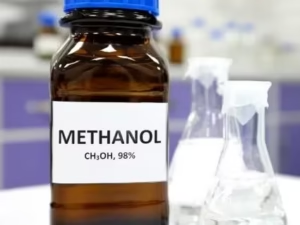Description
Butanol: A Versatile Alcohol with Growing Potential
Butanol, an alcohol with four carbon atoms, is emerging as a significant chemical with applications spanning fuel, solvents, and chemical building blocks. Unlike its more commonly known counterpart, ethanol, butanol boasts a higher energy content and lower volatility, making it a promising alternative fuel and a valuable ingredient in various industrial processes.
What is Butanol?
Butanol exists in four isomeric forms: n-butanol (also known as 1-butanol), isobutanol (2-methyl-1-propanol), sec-butanol (2-butanol), and tert-butanol (2-methyl-2-propanol). These isomers share the same chemical formula (C4H10O) but differ in the arrangement of their atoms, leading to variations in their physical and chemical properties. The most industrially relevant forms are n-butanol and isobutanol.
Production Methods:
Historically, butanol was primarily produced through fermentation using bacteria, a process known as the ABE fermentation (Acetone-Butanol-Ethanol). However, this method is relatively inefficient. Today, a significant portion of butanol production relies on petrochemical processes.
- Petrochemical Routes: Propylene, a byproduct of petroleum refining, is often used as a feedstock for butanol production via oxo processes. These processes involve reacting propylene with carbon monoxide and hydrogen in the presence of a catalyst to form butyraldehyde, which is then hydrogenated to butanol.
- Bio-based Production: Research and development efforts are increasingly focused on improving the efficiency of bio-based butanol production through advanced fermentation techniques. This involves using genetically engineered microorganisms and optimized fermentation conditions to enhance butanol yields from renewable biomass sources like corn, sugarcane, and cellulosic materials. This renewable pathway offers a more sustainable and environmentally friendly alternative to petrochemical-based production.
Key Applications:
Butanol’s unique properties make it a versatile chemical with a diverse range of applications:
- Fuel: Butanol is gaining traction as a biofuel. Its higher energy density (similar to gasoline) and lower volatility compared to ethanol make it a superior blending component for gasoline. It can be used in existing gasoline engines without significant modifications and offers improved engine performance. Butanol also reduces harmful emissions compared to traditional gasoline.
- Solvent: Butanol is an excellent solvent for a wide variety of substances, including paints, coatings, adhesives, and resins. Its superior solvency compared to ethanol and its ability to dissolve both polar and non-polar compounds make it a valuable ingredient in many industrial formulations.
- Chemical Intermediate: Butanol serves as a building block for the production of other chemicals, including:
- Butyl Acrylate: Used in the manufacturing of paints, coatings, and adhesives.
- Butyl Glycol Ethers: Used as solvents in cleaners, degreasers, and printing inks.
- Dibutyl Phthalate (DBP): Used as a plasticizer in PVC plastics (though its use is declining due to health concerns).
- Food Industry: Butanol is used as an extractant in the food industry and as an artificial flavoring agent in some food products.
Advantages of Butanol over Ethanol:
While ethanol is a more established biofuel, butanol offers several advantages:
- Higher Energy Content: Butanol contains more energy per volume than ethanol, resulting in better fuel economy.
- Lower Volatility: Lower volatility reduces evaporative emissions, improving air quality.
- Less Corrosive: Butanol is less corrosive than ethanol, minimizing the risk of damage to fuel systems.
- Easier Blending: Butanol can be blended with gasoline at higher concentrations than ethanol without requiring engine modifications.
- Hydrophobic: Butanol is less miscible with water than ethanol, reducing the risk of water contamination in fuel systems.
Challenges and Future Prospects:
Despite its advantages, butanol faces certain challenges:
- Production Costs: Bio-based butanol production is currently more expensive than ethanol production, primarily due to lower fermentation yields.
- Separation and Purification: Separating butanol from fermentation broth can be energy-intensive.
- Public Awareness: Butanol is less well-known to the public compared to ethanol.
However, ongoing research and technological advancements are addressing these challenges. Improved fermentation techniques, novel separation methods, and increasing awareness of butanol’s benefits are paving the way for its wider adoption.
Conclusion:
Butanol is a versatile alcohol with significant potential as a sustainable biofuel, a superior solvent, and a valuable chemical intermediate. As the demand for renewable energy and environmentally friendly chemicals grows, butanol is poised to play an increasingly important role in various industries. Continued research and development efforts will be crucial to optimizing its production and expanding its applications, ultimately contributing to a more sustainable future.

























Reviews
There are no reviews yet.